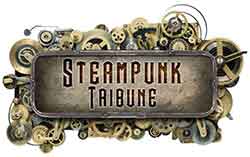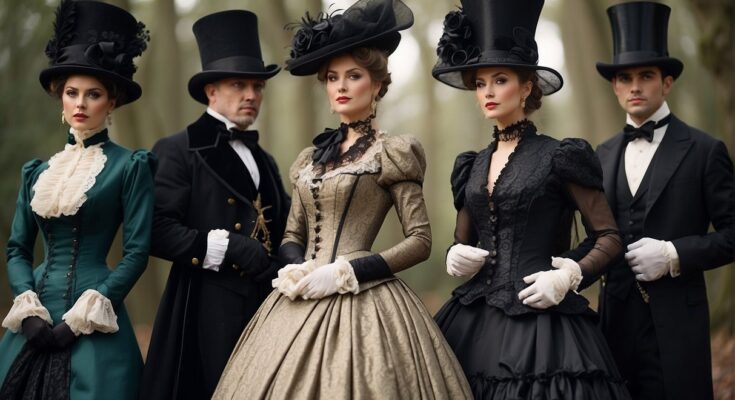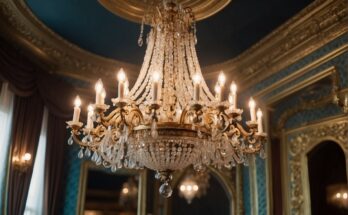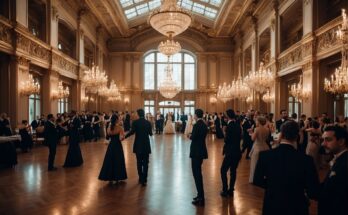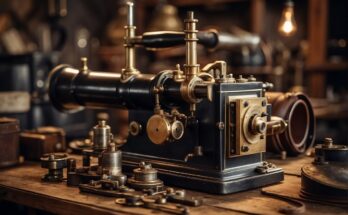The Victorian era, spanning from 1837 to 1901 under the reign of Queen Victoria, was a time of considerable change and innovation, which was reflected in the era’s fashion trends. This period in history witnessed a series of styles that not only signified one’s social status but also closely adhered to the moral and cultural ideals of the time. Fashion was an important aspect of Victorian society, and the intricate designs and elaborate garments worn, particularly by the middle and upper classes, were indicative of the era’s values and social stratification.

Victorian fashion was characterized by its emphasis on modesty, decorum, and stringent societal norms. For women, this meant dresses with long skirts, tight bodices, and high necklines, often complemented by elaborate bonnets and gloves. As the decades passed, the silhouette of women’s fashion changed dramatically from the voluminous skirts supported by crinolines to the slimmer, bustle-enhanced shapes of the later years. Men’s attire was comparably subdued but equally indicative of one’s status, consisting of well-tailored suits, waistcoats, and top hats.
Attention to detail was paramount, and both men’s and women’s clothing often featured intricate embroidery, lace, and other embellishments. As industrialization progressed, new textile technologies and the advent of sewing machines enabled more elaborate designs and the ability to produce clothing on a larger scale, making fashion more accessible to the burgeoning middle class. The trends of the Victorian era set the foundation for modern fashion and continue to influence designers and fashion enthusiasts to this day.
Historical Context
The Victorian era, named after Queen Victoria, spanned from 1837 to 1901 and was a period of significant transformation in British society. Under her reign, the British Empire expanded considerably, reinforcing its status as a global power.
Society: This epoch saw a rigid social hierarchy, with clear distinctions between the upper, middle, and working classes. Attire became a precise indicator of one’s social class, and strict codes of dress etiquette were adhered to, especially among the upper echelons.
Industry: The Industrial Revolution played a pivotal role during this time. Britain experienced immense industrial growth and prosperity, moving from agrarian-based economy to one dominated by machine manufacturing. The shift led to a surge in labor and the urbanization of society.
- Technological Advancement: Innovations in textile production revolutionized the fashion industry, allowing garments to be mass-produced.
- Growth: The burgeoning railway networks and improved communication systems facilitated the spread of fashion trends.
Clothing in this period reflected the society’s adherence to formality and decorum. While the Victorians are often remembered for their strict moral codes and conservative lifestyle, their fashion trends were an external manifestation of the era’s complex social tapestry – finely interwoven with threads of industrial prowess and technological advancements.
Influence of Society and Class

Victorian fashion was deeply influenced by the stratified structure of society, where clothing became a visible indicator of one’s social status and class. The upper class set the trends, often emphasizing luxurious fabrics and elaborate designs. Upper-class women were expected to wear full skirts, corsets to create a cinched waistline, and lavishly decorated hats.
The middle class was intent on social ascension and thus they emulated the styles of the upper class but with less opulence. Middle-class women’s fashion featured less extravagant versions of the upper-class trends, often made from more affordable materials.
For the lower class, practicality took precedence over fashion, and their clothing was more about durability and function. Lower-class garments were often second-hand or homemade, reflecting their limited economic means.
Society at large adhered to strict gender norms, with women’s fashion being distinct from men’s. Women’s garments were designed to accentuate a demure and feminine silhouette, whereas men’s clothing was more utilitarian and somber.
| Social Class | Women’s Fashion | Men’s Fashion |
|---|---|---|
| Upper Class | Luxurious, ornate | Tailored, sophisticated |
| Middle Class | Modest, less adorned | Practical, subdued |
| Lower Class | Durable, functional | Basic, hard-wearing |
Victorian fashion thus not only reflected an individual’s economic position but also societal expectations and gender norms that reinforced the social classes.
Dominant Fashion Trends and Styles

Victorian fashion evolved significantly from the early to late periods, marked by changing silhouettes and elaborate details reflective of societal values.
Early Victorian Fashion
The early Victorian era (1837-1850s) was characterized by fashion that emphasized a small waist and full skirt. Corsets were essential in creating the desired hourglass figure, cinching in women’s waists beneath their dresses. Sleeves started modest and ballooned into “leg-of-mutton” toward the 1830s end. Dresses usually featured a chemisette, adding modesty to the low-cut bodice, and often had a bertha neckline – a wide, deep collar that draped over the shoulders.
- Key Articles of Clothing:
- Dresses with a full skirt supported by petticoats
- Fitted bodices with narrow sleeves in the early 1830s, expanding to wider styles later
- Corsets to cinch the waist
- Chemisette for modesty
- Decorative bonnets tied under the chin
Mid-Victorian Fashion
During the mid-Victorian era (1860s-1870s), fashion saw dramatic changes with the introduction of the crinoline and later the bustle. Crinolines, hoop skirts made of steel framework, allowed skirts to expand to extreme widths. By the 1870s, the bustle took over, adding volume at the back of the skirt. Bodices became more elongated and the waistline dropped slightly. Mourning dress also became a detailed ritual, with mourning black and specific fabrics like crepe becoming prevalent for those in grief.
- Key Articles of Clothing:
- Crinolines then bustles for shaping the skirt
- Tight corsets with boning for a slim waist and pronounced hips
- Long-sleeved bodices that buttoned up the front
- Shawls and cuffs as popular accessories
Late Victorian Fashion
In the late Victorian era (1880s-1901), fashion continued to reflect social status and etiquette, but with new elements. The bustle grew larger before disappearing, while the sleeve size reduced. The hobble or trumpet skirt came into fashion, fitting tightly over the hip and flaring at the hem. An emphasis on artistic aesthetic also evolved, with lace, ruffles, flounces, and intricate details becoming widespread. Despite the restrictive nature of corsets, which grew even more constricting, the overall silhouette became simpler.
- Key Articles of Clothing:
- Skirts that were slim at the hip and flared at the hem, often with a small bustle
- High-necked bodices with shoulder straps and puffed upper sleeves
- Evening gowns with low-cut necklines and short sleeves for formal events
- Bonnets evolved into small, elaborate hats adorned with feathers and ribbons
Technological Innovations Impacting Fashion
During the Victorian era, technological advancements played a pivotal role in shaping fashion trends. The introduction of the sewing machine in the mid-19th century revolutionized garment production. It enabled quicker stitching, which increased efficiency and allowed for more elaborate designs and decoration.
The development of synthetic dyes brought a burst of color to Victorian wardrobes. Previously limited to natural dyes, which were often muted, manufacturers could now produce a vast array of vibrant hues. This innovation greatly influenced the popularity of vividly colored garments during the period.
| Innovation | Impact on Fashion |
|---|---|
| Sewing Machine | Accelerated garment production; complex designs |
| Synthetic Dyes | Introduces vibrant colors; variety in fabric appearance |
In terms of structure, steel served a critical function in the creation of the cage crinoline. This framework allowed women’s skirts to expand dramatically without the weight of multiple petticoats. The cage crinoline was beloved for its comfort and practicality, as it gave freedom of movement and marked a significant shift in silhouette.
Fashion technology of the era wasn’t limited to clothing production. Innovations such as paper patterns facilitated the replication of popular styles at home, making fashion more accessible. These advancements collectively fostered a pivotal transformation in the fashion industry, streamlining production and giving rise to a dynamic era of style characterized by shape, color, and ornamentation.
Materials and Construction
Victorian era fashion stood out for its elaborate materials and sophisticated construction techniques. Quality fabrics and precise tailoring were the hallmark of the period, reflecting the societal emphasis on appearance and status.
Fabric and Color
Victorian fashion heavily featured natural fabrics like silk, cotton, and velvet. These materials were favored for their rich textures and capacity to absorb the newly popular synthetic dyes. The advent of synthetic dyes brought vibrant colors into vogue, with purple and pink becoming particularly fashionable.
- Silk: Luxurious and often used for formal wear.
- Cotton: Common for everyday attire due to its comfort and durability.
Lace also became more accessible thanks to industrialization and was widely used to embellish garments, adding a touch of elegance.
Undergarments
Undergarments were crucial to the Victorian silhouette and included several layers, with the corset being the most emblematic piece. Made with steel boning and tight lacing, corsets sculpted the waist to adhere to the period’s beauty standards.
- Corsets: Constructed of cotton or silk, reinforced with steel for structure.
- Crinolines: These horsehair or steel-framed undergarments supported the voluminous skirts.
Underneath it all, a simple cotton undergarment was typically worn next to the skin to protect the outer garments from sweat and oils. Victorian fashion’s complexity and refinement were very much built from the inside out, with undergarments shaping the overall appearance.
Accessories and Complementary Items
Victorian fashion is renowned for its intricate accessories and complementary items, each serving both practicality and ornamentation. They are key to understanding the era’s aesthetic sensibilities.
Headwear
During the Victorian era, headwear was an essential fashion item for both men and women. Women commonly donned bonnets, which were often adorned with ribbons, lace, feathers, and artificial flowers. Hats were structured with a variety of materials, and the introduction of the top hat for men signified stature and gentility.
- Bonnets: Typically made of straw or fabric, with ruffles and tied under the chin.
- Top Hats: Constructed from silk or felt, these were a symbol of sophistication among men.
Footwear and Gloves
Footwear and gloves reflected one’s social status and were pivotal in Victorian attire. Ladies’ shoes were often made of satin or kid leather with button closures, and were mainly high-topped. Men’s shoes leaned towards practicality but still maintained a sense of style.
- Shoes: Characterized by low heels and pointed toes for women; boots and laced shoes for men.
- Gloves: Gloves were compulsory for social events; often crafted from silk or soft kid leather to above the elbow length for women, while men’s were shorter and sturdier.
Jewelry and Adornments
In the Victorian era, jewelry and adornments carried deep significance and communicated one’s wealth and social standing. Mourning jewelry made from jet, a black fossilized wood, became popular after Queen Victoria wore it as part of her mourning dress. Fans and shawls were also staple accessories, not merely for practical use but also for signaling subtle social cues.
- Jewelry: Often included brooches, lockets, and cameo pendants, with common use of gold and precious stones.
- Fans and Shawls: Embroidered shawls for women, and fans were used to convey messages discreetly, in addition to providing ventilation.
Cultural Influences on Victorian Fashion
Victorian fashion was notably influenced by various elements of culture. Literature during this period often reflected and shaped the public’s views on attire. For instance, the novels of Charles Dickens and Jane Austen showcased the social customs and dress of the time, reinforcing the era’s fashion ideals.
In art, the Pre-Raphaelite Brotherhood, a group of English painters, poets, and critics, influenced fashion with their medievalist depictions of women in flowing gowns and intricate hairstyles. This artistic movement impacted the silhouettes and ornamentation in women’s dresses, emphasizing an ethereal aesthetic.
Architecture of the Victorian era, characterized by the Gothic Revival and classical styles, also played a role in fashion. The ornate and elaborate detailing found in buildings translated into complex garments with high collars, full skirts, and a preference for velvet, silk, and lace to mimic the grandeur of Victorian construction.
The expansion of the British Empire had a profound impact on Victorian fashion. Britain’s colonies in India, Africa, and the Caribbean introduced new textiles and jewels to the homeland, which were assimilated into the fashion of the day. This era saw the incorporation of Indian silks, cashmere shawls, and vibrant patterns into the Victorian wardrobe, showcasing the Empire’s influence.
| Cultural Aspect | Influence on Fashion |
|---|---|
| Literature | Reinforced fashion ideals |
| Art | Inspired ethereal aesthetics |
| Architecture | Prompted ornate detailing |
| British Empire | Introduced new fabrics |
The garments from the Victorian period were more than mere clothing; they were a complex tapestry woven from the diverse cultural elements of the time.
Fashion Etiquette and Dress Codes
During the Victorian era, etiquette heavily influenced fashion, with societal norms dictating appropriate attire for various occasions. Morning dress was formal attire worn by men, typically for upmarket events and social calls, which often involved a tailcoat and matching trousers. Conversely, women observed strict rules about garment choice, particularly regarding décolleté—the upper part of a woman’s dress. Low décolleté was reserved for evening social events, while high necklines were deemed proper for daytime.
For mourning, a period of grieving led to somber and strict dress codes. Widows were expected to wear mourning dress for up to two years, donning black clothing which symbolized the loss and respect for the deceased. Gradually, they could transition to less restrictive attire, shifting from deep black to lighter shades of gray and purple as mourning waned.
| Dress Code | Description | Gender |
|---|---|---|
| Full dress | The most formal evening attire, including tailcoats for men and gowns with décolleté for women. | Both |
| Half mourning | The latter phase of mourning dress, permitting a return to soft colors and less stringent styles. | Women |
| Rational Dress | Reform movement proposing comfortable clothing to replace the restrictive corsets and crinolines. | Women |
The Rational Dress Society, established in 1881, challenged these stiff sartorial standards, advocating for women’s fashion that did not compromise their health. They promoted garments that allowed greater freedom of movement, eschewing tight lacing and heavy skirts for more practical attire.
In upper-class society, attending the opera or a ball required adherence to strict dress codes. For men, this often meant white tie and tails, whilst women displayed fashion-forward elegance, with a balance between opulence and tastefulness, often in the shape of elegant gowns abiding by the event’s level of formality.
Gender Roles and Fashion
Victorian fashion was shaped significantly by gender roles, reflecting the societal norms and expectations of the era. Women’s clothing was designed to emphasize modesty and femininity, often including corsets and voluminous skirts. The corset served as a pivotal undergarment that defined the period’s silhouette, tightly cinching the waist and supporting the bust.
Men’s attire, conversely, was more practical and less restrictive. Tailcoats, frock coats, and morning coats were prominent, each suitable for different occasions. Men’s fashion aimed for a dignified and controlled appearance, highlighting their supposed rationality and authority.
The Rational Dress Society, established in 1881, challenged these restrictive norms by advocating for women’s clothing that allowed freedom of movement, without the tight lacing of corsets. The society’s principles were a response to Victorian fashion’s impact on health and mobility.
| Gender | Garment | Purpose | Example of Modesty |
|---|---|---|---|
| Female | Corset | Waist cinching | High necklines, long skirts |
| Male | Tailcoat | Formal wear | Conservative colors, fitted but practical |
Victorian society placed a high premium on modesty, which was reflected in clothing choices. Women were expected to wear multiple layers, including petticoats and bustles, to maintain a respectable appearance. Even as the Rational Dress Society promoted changes, Victorian fashion largely continued to enforce traditional gender roles through clothing.
Fashion during the Victorian era was not merely about style. It was a reflection of the societal structures and the gender-specific expectations that underpinned Victorian society. Both men’s and women’s clothing were not only a personal choice but also a statement of their social standing and adherence to societal norms.
Fashion Communication and Distribution
During the Victorian era, fashion magazines played a critical role in disseminating style trends to the public. Publications such as The Ladies’ Cabinet and Godey’s Lady’s Book offered monthly illustrations of clothing, which often included elaborate descriptions.
| Periodical | Audience | Impact |
|---|---|---|
| The Ladies’ Cabinet | Middle-class women | Illustrated current fashion trends |
| Godey’s Lady’s Book | American women | Spread of European styles to America |
Department stores emerged as fashion emporiums, showcasing a vast array of clothing accessible to a wider consumer base. Stores such as Harrods in London and Le Bon Marché in Paris not only sold the latest fashion but also allowed people to see and be seen in their fashionable attire.
Haute couture, a term coined in the late 19th century, referred to the creation of exclusive custom-fitted clothing. It became synonymous with French designers such as Charles Frederick Worth, who is often credited as the first couturier. His designs were widely publicized, leading to fashion trends that spread beyond the aristocracy to department stores’ mass-produced versions.
The Victorian era witnessed a unique interplay between handmade haute couture creations and the mass-market appeal of department stores. This synergy was key to the proliferation of fashion trends and is regarded as a foundational period for modern fashion marketing and distribution.
Evolution of Victorian Fashion
During the Victorian era, fashion underwent significant transformations as industrial advances enabled more production and variation in clothing. The early Victorian period emphasized modesty and demure silhouettes, which was reflected in tight waistlines, full skirts, and high necklines. Women’s fashion saw the introduction of the crinoline in the 1850s, a device that allowed skirts to expand in width while reducing the weight of the fabrics.
Men’s fashion, while less variable, also evolved. The introduction of the sack coat and the gradual decline in the wearing of tailcoats marked a shift towards more practical attire.
By the mid-Victorian period, the crinoline evolved, and the hoop skirt took its place, entailing a smoother bell-shaped silhouette. Fabrics became more elaborate and colorful as aniline dyes were introduced. The later Victorian period saw the bustle replacing the crinoline, creating a pronounced rear silhouette.
Children’s fashion mimicked adult attire but with more comfort considered. Boys wore tunics and later, knickerbockers, while young girls’ dresses followed the trends of their mothers with some modifications for mobility.
Victorian fashion trends were shaped by social norms and industrial innovations. The sewing machine, patented in the 1850s, revolutionized the industry, making clothing more accessible and varied.
In summary, the evolution of Victorian fashion reflects broader social changes and technological advancements of the time, characterized by changing silhouettes and the increasing practicality of dress.
| Timeline | Fashion Element | Description |
|---|---|---|
| Early Victorian Era | Silhouette | Full skirts, tight waistlines |
| 1850s | Crinoline | Large, lightweight skirts |
| Mid-Victorian Era | Hoop Skirt | Bell-shaped skirts |
| Late Victorian Period | Bustle | Emphasis on rear silhouette |
The Victorian era’s fashion legacy continues to influence style and retains a romantic allure in contemporary fashion culture.
Economic and Social Factors
The Victorian era’s fashion trends were significantly influenced by both economic and social factors during that time, closely associated with the Industrial Revolution. This period saw a shift in the production of textiles, with the introduction of machinery that reduced the cost of clothing and allowed for mass production.
Social Class Distinctions
| Upper Class | Middle Class | Lower Class |
|---|---|---|
| Lavish fabrics, tailored fits | Quality, yet less ornate garments | Simple, durable clothing |
The upper class, comprising the social elite, had the financial means to afford high-quality, luxurious garments and regularly commissioned custom-made attire to display their social status. Middle-class citizens often had garments that were well-made but less ostentatious, as a means of expressing their respectability and burgeoning status. The lower class, meanwhile, wore practical and durable clothing suited to manual labor and often purchased second-hand or made do with what was available.
Socio-Economic Contrasts
- Upper class: Wealth from industrialization allowed them to spend lavishly.
- Middle class: Growth led to affordable, quality fashion, mimicking the upper class.
- Lower class: Economic constraints necessitated practicality over style.
The industrial revolution also brought about the rise of department stores and ready-made clothing, which democratized fashion to some extent. However, there was still a stark contrast in the quality and style of clothing available to different classes. The upper-class women could change outfits multiple times a day, while lower-class garments had to be multifunctional and durable to withstand daily rigors.
These economic and social factors together shaped the distinctive fashion trends of the Victorian era, reflecting the class distinctions and industrial advancements of the time.
Leisure and Sports Influences
During the Victorian era, leisure activities and sports had a significant impact on fashion, influencing the design and functionality of clothing.
Tennis: As tennis gained popularity, women wore corseted bodices and bustled skirts that gradually became simpler, allowing more freedom of movement. The iconic white ensemble for tennis emerged, characterized by a long-sleeve blouse and a flared skirt.
Croquet and Archery: For outdoor activities like croquet and archery, Victorian fashion included tailored jackets paired with crinoline-supported skirts. As practicality became essential, less restrictive styles were adopted.
| Sport | Women’s Attire | Men’s Attire |
|---|---|---|
| Riding | Riding habits, close-fitting jackets | Tailcoats, tight breeches |
| Yachting | Nautical-themed outfits, sailor collars | Nautical blazers, flannel trousers |
Swimming: Swimwear was born out of the need for appropriate attire at beaches and spas. Early Victorian swimwear for women included voluminous bathing gowns, often made from wool or flannel to prevent transparency when wet. Men’s swimwear consisted of striped one-piece garments.
Golf and Cycling: These sports necessitated practical attire. Ladies took to the links in ankle-length skirts, while cyclists adopted bloomers, which were baggy knee-length pants, causing considerable social debate due to their departure from traditional norms.
In summary, Victorian leisure and sports largely influenced the period’s fashion, leading to more practical designs that facilitated ease of movement while also maintaining the era’s standards of modesty and propriety.
Danger and Health Concerns
Victorian fashion, while visually striking, carried with it numerous health and safety hazards. Most notably, tight corsets were a staple of women’s fashion that reshaped the torso and waist to an extreme hourglass figure. This practice, known as tight-lacing, posed several risks:
- Respiratory Issues: Tight corsets restricted lung function, leading to shallow breathing and a lack of oxygen.
- Digestive Problems: Corseting could lead to displacement and constriction of internal organs, affecting digestion.
- Musculoskeletal Damage: Long-term corset wear could deform the ribs and spine.
Another danger came from the use of certain dyes and materials that contained toxins, such as arsenic in green dresses, which could lead to poisoning. Here is a breakdown of health-related issues:
| Health Concern | Cause | Consequence |
|---|---|---|
| Respiratory problems | Tight corsets | Difficulty breathing, fainting |
| Digestive issues | Organ compression | Indigestion, constipation |
| Musculoskeletal damage | Long-term corset wearing | Deformed ribs, scoliosis |
Furthermore, voluminous skirts and dresses often were a fire hazard near open flames, a common occurrence in an era reliant on candles and gas lamps. The combination of health concerns and potential accidents contributed to the complexity of Victorian attire and its impact on an individual’s everyday wellness.
